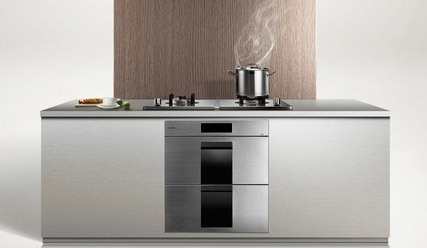How much do you know about kitchenware?
Apr 21,2025

We use kitchen utensils every day, but how much do you know about the basics of kitchen utensils? Let me share some practical tips with you~
I. Kitchen utensils are mainly divided into the following five categories:
One category is storage utensils, which are divided into two parts: food storage and utensil storage. Food storage is further divided into cold storage and non-cold storage. Cold storage is achieved through refrigerators and freezers in the kitchen. Utensil storage provides storage space for tableware, cookware, and other utensils. Storage utensils are achieved through various base cabinets, wall cabinets, corner cabinets, and multi-functional decorative cabinets.
The second category is washing utensils, including cold and hot water supply systems, drainage equipment, washbasins, wash cabinets, etc. Garbage generated during kitchen operations after washing should be placed in garbage cans or sanitary buckets. Modern home kitchens should also be equipped with disinfection cabinets and food waste disposers.
The third category is preparation utensils, mainly including preparation countertops, tools and utensils for sorting, cutting vegetables, seasoning, and mixing. With the advancement of technology, home kitchens are also constantly adding food cutting machines, juicers, and mixing machines.
The fourth category is cooking utensils, mainly including stoves, cooktops, and related tools and utensils for cooking. With the progress of the kitchen revolution, infrared gas stoves, high-frequency induction cooktops, microwave ovens, and microwave ovens have also begun to enter homes in large numbers.
The fifth category is dining utensils, mainly including furniture in the dining room and utensils and tableware used during meals.
How should we choose suitable kitchen utensils?
Take infrared gas stoves as an example. Qualified infrared gas stoves are flameless combustion, while some infrared products use fully premixed combustion, and the combustion reaction takes place inside and on the surface of the fire hole. Although the flame on the surface of the fire hole is very short, it is considered flameless combustion, but it is not truly flameless combustion (there is a short flame). True flameless combustion mainly controls the reaction on the catalyst surface inside the fire hole. During combustion, it can achieve a completely flameless combustion state, truly achieving flameless combustion.
For example, the Hongri infrared gas stove. In addition to the above-mentioned energy-saving, environmentally friendly, and non-smoking features, the Hongri independently developed infrared patented core technology "multi-porous ceramic plate" has more than 7500 fire holes, and the average service life of the ceramic plate is 8 years. During combustion, the high-temperature ceramic plate does not crack when it encounters water, and has excellent resistance to thermal shock, so that the Hongri infrared energy-saving stove can have high firepower and wind and water resistance. Infrared rays have penetration ability, which shortens the heating time of objects, and the surface temperature can reach 1100 to 1300 degrees Celsius, while ordinary open-flame stoves are only between 600 and 800 degrees Celsius. Infrared stoves have no flames and are not affected by wind. When stewing soup, if the soup accidentally overflows, it is easy to extinguish the flame and easily be extinguished by the soup.
Finally, I hope this helps everyone~
Previous Page:
Next Page:

Subverting Tradition, Ushering in a Kitchen Revolution
Address: No. 9, Xinghe Road, Rongbian Tianhe Industrial Zone, Shunde District, Foshan City, Guangdong Province
Copyright © Foshan Gumei Electrical Appliance Co., Ltd.




